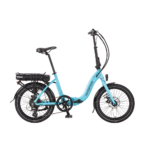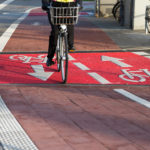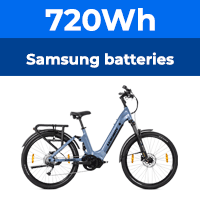Stupid Question. UK Law. Would two 250w motors fitted be classed as 500w?
- Thread starter DCUK6
- Start date
I think you would need to get a copy odf the relevant Act of Parliament and or Statutory Instrument to be sure of the wording. I would e mail or write to the Dept responsible for the legislation for clarification.
D
Deleted member 4366
Guest
Very good question. Often when people make rules, they make assumptions, so it's possible they slipped up with the wording. If the wording says something like ..."a motor not more than 250w", it could be interpreted that two motors are not allowed even if together they only added to 250w. I'll wait for someone to say what the actual wording is before I pass judgementHi,
Almost know the answer before posting but would two 250w mortors, say rear hub and crank, fitted to the same bike be classed as 500w.
The law i believe states the motor and not the total bike power.
Just interested.
Slightly off topic, but how would you rig that? Pedelec rear and twist'n'go front for that extra assistance?
D
Deleted member 4366
Guest
You have a choice. Your suggested way is the easiest. Some people used two throttles: A left and a right one. Others, like me use a double throttle so that one throttle works two controllers. You can make a double throttle by gluing an extra hall sensor into one.Slightly off topic, but how would you rig that? Pedelec rear and twist'n'go front for that extra assistance?
From the EU law, incorporated into UK law 10th November 2003:Very good question. Often when people make rules, they make assumptions, so it's possible they slipped up with the wording. If the wording says something like ..."a motor not more than 250w", it could be interpreted that two motors are not allowed even if together they only added to 250w. I'll wait for someone to say what the actual wording is before I pass judgement
(h) cycles with pedal assistance which are equipped with an auxiliary electric motor having a maximum continuous rated power of 0,25 kW, of which the output is progressively reduced and finally cut off as the vehicle reaches a speed of 25 km/h, or sooner, if the cyclist stops pedalling.
That is the exemption from being a motor vehicle needing type approval or SVA. It clearly does not say that two such motors are exempt, only "an auxilliary electric motor". It follows that a 2 x 250 watt motor equipped bike does not qualify as exempt from motor vehicle law.
From the UK law:
(c)be fitted with no motor other than an electric motor which—
(i)has a continuous rated output which, when installed in the vehicle with the nominal voltage supplied, does not exceed-
(A)in the case of a bicycle, other than a tandem bicycle, 0.2 kilowatts,
(B)in the case of a tandem bicycle and a tricycle, 0.25 kilowatts
So overall two 250 watt motors are not legal.
.
Last edited:
Quite sensible limiting the motor to one of no more than 250w.
Other wise you could have any number of sub 250w motors fitted
Not too sure about having double windings inside one motor case though (One for speed, one for hills) if the change over between windings is handled internally, because from the outside and on measuring rigs the motor would perform within the law
Other wise you could have any number of sub 250w motors fitted
Not too sure about having double windings inside one motor case though (One for speed, one for hills) if the change over between windings is handled internally, because from the outside and on measuring rigs the motor would perform within the law
There have been motors with star/delta or dual tapped winding connections to give the two performance modes. Team Hybrid used to supply one, but as they warned, the consumption one of the modes can be very high. As ever, compromise dual-purpose solutions have downsides.Quite sensible limiting the motor to one of no more than 250w.
Other wise you could have any number of sub 250w motors fitted
Not too sure about having double windings inside one motor case though (One for speed, one for hills) if the change over between windings is handled internally, because from the outside and on measuring rigs the motor would perform within the law
On a slightly more likely open to interpretation note: what about two 125w motors or 2x 250w motors that have the 250w shared / not going over 250w continuous between them? essentially 2 motors behaving as one motor not over 250w continuous?
That will be legal, since the relevant EN15194 technical standard has one of the tests for power being a timed acceleration under controlled conditions, no mention of direct measurement of the motor.On a slightly more likely open to interpretation note: what about two 125w motors or 2x 250w motors that have the 250w shared / not going over 250w continuous between them? essentially 2 motors behaving as one motor not over 250w continuous?
.
thanks… that makes what I want to do much easier and better!That will be legal, since the relevant EN15194 technical standard has one of the tests for power being a timed acceleration under controlled conditions, no mention of direct measurement of the motor.
.
Bear in mind that a true 250 watts limit would be almost useless. In practice most pedelec motors can supply 400 to as much as 600 watts of power for shorter periods.thanks… that makes what I want to do much easier and better!
Where you could be likely to hit legal trouble is if you use two motors each marked as being 250 watts. The police have no way to test the actual power so might prosecute on the basis that you had 500 watts total, regardless of your controller arrangements. The magistrates would convict if you could not prove otherwise with the support of a technical expert in court. That might be difficult to obtain since your motors arrangment would really need to peak at far above 250 watts, at least double that to be useful. So as a start point you should make sure your motors have no marked power or are each marked 125 watts.
.
Thanks. I will get it properly tested, and verified by an expert, the key really is if there is anything that states it can only be one motor which it appears there is not? ultimately most of these motors can be “unlocked” to way more than 250w and often do peak within legal requirements higher than 250w, as the regulation is continuous, not peak? However ultimately I will be supplying the two motors with no more power than I would just one and so they will have to split it! What is key for me is the traction and then upgradeability… so when the law its upped to 500w, which I would assume it will be, and will be lobbying for, at least for cargo bikes, then you are ready. the 125w sticker is an amusing one, but it probably needs to be 250w ‘total output’ on the frame / controller to be honest about it?Bear in mind that a true 250 watts limit would be almost useless. In practice most pedelec motors can supply 400 to as much as 600 watts of power for shorter periods.
Where you could be likely to hit legal trouble is if you use two motors each marked as being 250 watts. The police have no way to test the actual power so might prosecute on the basis that you had 500 watts total, regardless of your controller arrangements. The magistrates would convict if you could not prove otherwise with the support of a technical expert in court. That might be difficult to obtain since your motors arrangment would really need to peak at far above 250 watts, at least double that to be useful. So as a start point you should make sure your motors have no marked power or are each marked 125 watts.
.
Unlikely for two reasons. An upgrade for cargo bikes etc already went through 6th April 2015 when all e-bike weight limits were removed. The second reason is that there is already a class for bicycle based 15.5 mph, allowing 1000 watts. That's a class called L1e-A, but here in Britain they have to be registered as a motor vehicle with all that implies.when the law its upped to 500w, which I would assume it will be, and will be lobbying for, at least for cargo bikes, then you are ready.
Frame labelling is the legal way, technically in law this is what it should be:the 125w sticker is an amusing one, but it probably needs to be 250w ‘total output’ on the frame / controller to be honest about it?
"As part of the GB EAPC amending legislation, that will come into force on 6 April 2015, the requirement for the marking identification has been amended. From April 6 2015 the requirement will be that the manufacturer, maximum continuous rated output and maximum assisted cutoff speed shall be marked on the cycle in a prominent position."
You can relax on the two motor point, there was a commercial precedent, the SRAM Sparc which had two motors incorporated within its wheel hub. The last pedelec using it was the Carrera Sparc sold by Halfords. The photo below shows the works and you can see the two small motors:Thanks. I will get it properly tested, and verified by an expert, the key really is if there is anything that states it can only be one motor which it appears there is not?

See the SRAM above Neal. Nowhere in the type approval or pedelec law specifies only two motors, only references to "the motor".Some where in the dvla rules there is something that says two motors are not allowed.
Also almost all hub motors are incomplete since they cannot run without a controller. With the two in different positions on most e-bikes, clearly "the motor" can be in two parts in different places on the bike.
.
Interested to know the 'why' bit of your two 125W motors. Is this front / rear, or two wheel drive tricycle, or you just happen to have two such motors lying around?Thanks. I will get it properly tested, and verified by an expert, the key really is if there is anything that states it can only be one motor which it appears there is not? ultimately most of these motors can be “unlocked” to way more than 250w and often do peak within legal requirements higher than 250w, as the regulation is continuous, not peak? However ultimately I will be supplying the two motors with no more power than I would just one and so they will have to split it! What is key for me is the traction and then upgradeability… so when the law its upped to 500w, which I would assume it will be, and will be lobbying for, at least for cargo bikes, then you are ready. the 125w sticker is an amusing one, but it probably needs to be 250w ‘total output’ on the frame / controller to be honest about it?
great! many thanks! re two motors precedent.Unlikely for two reasons. An upgrade for cargo bikes etc already went through 6th April 2015 when all e-bike weight limits were removed. The second reason is that there is already a class for bicycle based 15.5 mph, allowing 1000 watts. That's a class called L1e-A, but here in Britain they have to be registered as a motor vehicle with all that implies.
Frame labelling is the legal way, technically in law this is what it should be:
"As part of the GB EAPC amending legislation, that will come into force on 6 April 2015, the requirement for the marking identification has been amended. From April 6 2015 the requirement will be that the manufacturer, maximum continuous rated output and maximum assisted cutoff speed shall be marked on the cycle in a prominent position."
You can relax on the two motor point, there was a commercial precedent, the SRAM Sparc which had two motors incorporated within its wheel hub. The last pedelec using it was the Carrera Sparc sold by Halfords. The photo below shows the works and you can see the two small motors:
View attachment 46099
Related Articles
-
 MTF Enterprises announces acquisition of EMU Electric Bikes
MTF Enterprises announces acquisition of EMU Electric Bikes- Started by: Pedelecs
-
 Wisper 806T folding bike wins Which? ‘Best Buy’
Wisper 806T folding bike wins Which? ‘Best Buy’- Started by: Pedelecs
-
 Sustrans calls for protected cycle lanes
Sustrans calls for protected cycle lanes- Started by: Pedelecs
-
 Amazon launch their first UK e-cargo micromobility hub
Amazon launch their first UK e-cargo micromobility hub- Started by: Pedelecs



